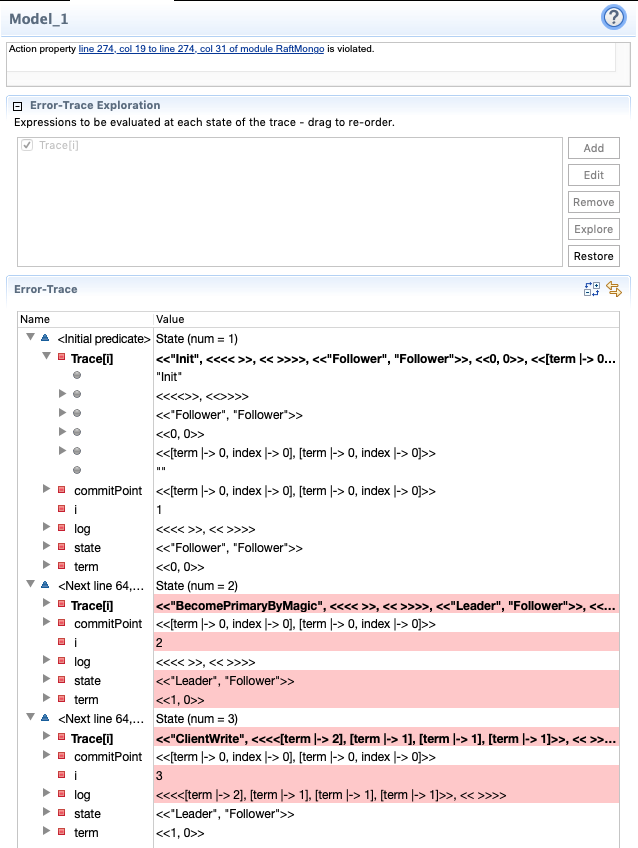Compare a sequence of state transitions logged by an actual MongoDB replica set with our Raft-like TLA+ specification to check whether the replica set's behavior is permitted by the spec.
TLA+ is a mathematical language for specifying distributed systems algorithms. A TLA+ spec can be checked with TLC, a tool that verifies that any sequence of steps the algorithm can perform will obey the spec's invariants. However, checking that a TLA+ spec is correct does not guarantee that the spec matches your actual program. One solution is model-based trace-checking[1]: check that actual executions of your program, e.g. during integration tests, each match some sequence of steps permitted by the spec. We implement a model-based trace-checking technique specific to TLA+ described by [2].
[1]. Howard, Yvonne & Gruner, Stefan & Gravell, A & Ferreira, Carla & Augusto Wrede, Juan. (2011). Model-Based Trace-Checking.
[2]. Pressler, Ron. (2018). Verifying Software Traces Against a Formal Specification with TLA+ and TLC.
I want to check that an actual MongoDB replica set's series of state changes
correspond to a sequence of steps in MongoDB's TLA+ spec, RaftMongo.tla.
First I run mongod with extra tracing. Each time the server executes a step
that is equivalent to one of the RaftMongo.tla actions (AppendOplog,
RollbackOplog, BecomePrimaryByMagic, or ClientWrite), it logs the actual values
of all variables that are modeled by the spec. I start a replica set, perform
some writes, and stop the set.
Next, I run a Python script reads all the replica set members' logs and constructs an execution trace, as follows. The script begins with the spec's initial state. Then, for each log message from the replica set, the script creates the next state, which includes the changes expressed by the log message. For example, if Server 1 becomes primary, it logs that its role is now "Leader". The script makes the next state, which is the same as the previous except for Server 1's new role.
Once the script has created the trace, it follows the technique described in
[2]. It formats the trace as a TLA+ tuple of tuples of variable values, and
creates a new TLA+ spec to check that this trace is permitted by
RaftMongo.tla.
Run a replica set
- Clone this repository
- In a separate directory, check out github.com/mongodb/mongo at revision 8a4dba3b.
- Build
mongodandmongo. - Run the script included in this repository.
./mongo --nodb jstests/bulk_write.js
Run the checker
- With Python 3.7 or later:
python -m pip install -r requirements.txt
python repl-trace-checker.py <LOG1> <LOG2> ... <MONGO_CHECKOUT>/src/mongodb/repl/tla_plus/RaftMongo/RaftMongo.tla
- Replace LOG1, LOG2, etc. with the
mongod.logfile of each replica. - Replace MONGO_CHECKOUT with the path to the mongodb repository checkout.
The script parses the mongod log files and generates a TLA+ spec which checks
that the trace represented by the log files is permitted by RaftMongo.tla.
The script installs or updates the TLA+ tools and runs the model checker program
TLC on the generated spec.
Caveats:
- If a mongod's log is split across several files (for example, if it restarted during the test), include all its log files.
- The replica set must never be single-node (because single-node sets handle
the commitPoint differently from the RaftMongo.tla spec). You must disable
replsettest.js's default behavior of initializing a set with one node and then
adding the remainder of the nodes.
bulk_write.jshandles this correctly. - Auth is not supported: it writes system.keys entries that are majority-committed during initial sync as the replica set is initialized, which violates RaftMongo.tla.
Debug
When the script finds a violation of the spec it logs something unhelpful like:
Error: Action property line 274, col 19 to line 274, col 31 of module RaftMongo is violated.
You can use the TLA+ Toolbox IDE to debug it.
- Run
repl-trace-checker.py --keep-temp-spec. - Open the generated Trace.tla in the TLA+ Toolbox.
- Choose "TLC Model Checker" -> "New Model".
- Under "What is the behavior spec?" choose "Temporal formula" and enter "TraceBehavior".
- Under "Properties" click "Add" and enter "SpecBehavior".

- Choose "TLC Model Checker" -> "Run Model". You should see a violation error and an error trace.
- In "Error-Trace Exploration" click "Add" and enter
Trace[i]. Click "Explore". - More information will be added to the error trace, including the spec action
the server thought it took at each step, and the MongoDB server log line that
generated each step.

Trace logging is implemented in mongod as of commit f515d2ad on MongoDB's master
branch. Only very simple behaviors such as the included bulk_write.js can
pass trace-checking. More complex behaviors reveal mismatches between the spec
and the implementation. This is the purpose of the project! However, we have
decided to stop this experiment instead of fixing the discrepancies.
Sample output from the trace checker.
- Trigger a rollback and check its trace.